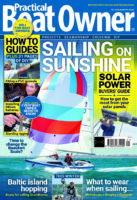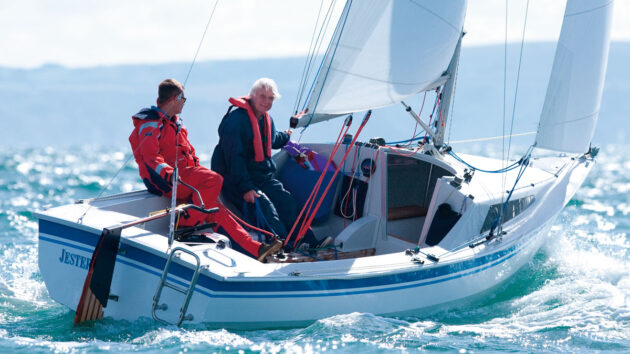When the Hawk 20 appeared she was hailed as the dayboat that did everything. This model was later followed by the Cruiser version with a cabin. David Harding reports
Hawk 20 Cruiser: fast, fun and functional trailer-sailer
Nearly 36 years after the Hawk 20 burst onto the dayboat scene, she is still desirable for anyone wanting something around 6m (20ft) long that’s fast, unsinkable, self-draining, self-righting and easy to trail, launch and recover.
Add the Hawk’s enormous cockpit, her reputation for being well built and her renowned competence in heavy weather, and it’s no surprise that hundreds have been sold.
When Reid Marine developed her with the designer, Chris Hawkins, they weren’t after building something for the lowest possible price.
Refreshingly, they decided to create a boat that was as good as they could make it, to build it with the most appropriate materials and to equip it with the best kit they could find.
As a result, there really wasn’t a lot for anyone to criticise – unless, that is, they wanted something cheap.
Neither is she the most elegant of boats, and if you favour traditional appeal, you’re more likely to go for the BayCruiser or a modern-gaffer like the Cornish Shrimper.
If modern functionality and the option to join in some one-design racing is what you’re after, the Hawk has long been the boat that sets the pace.
All she originally lacked in some people’s eyes was a cabin. She was such a good seaboat and swallowed the miles so readily that the more adventurous owners inevitably started going off on cruises, sleeping on the cockpit sole beneath a boom-tent and keeping their kit in the cavernous watertight stowage compartment in the bow.
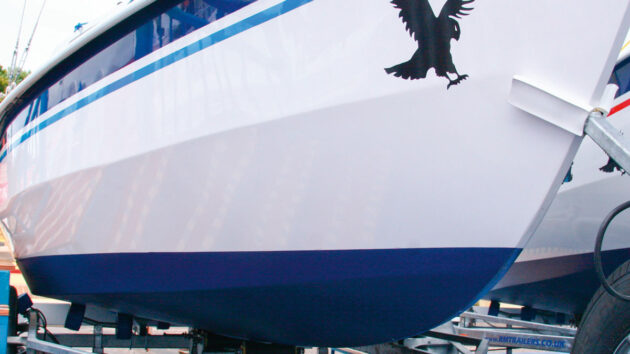
Sharp chines: the flat sections contribute to high form stability. Credit: David Harding
Suggestions that Reid develop a cabin version appeared to have no effect. ‘It is a dedicated dayboat with no pretence at being anything else, ’ proclaimed the brochure.
Until the Lidded Hawk (otherwise known as the Hawk 20 Cruiser or cabin version) became available, which sold faster than the dayboat, and it’s easy to see why.
Because the dayboat’s raised foredeck extends abaft the mast, creating an enormous space in the bow that’s almost a cabin in its own right, all that was needed was a few inches more height, a couple of windows and a companionway, and the oversized locker became a snug two-berth cabin with space for a cooker and a loo.
In practice, it wasn’t quite as simple as that, of course – boat design and re-tooling never is – but the point is that the cabin uses space that was there already and has minimal effect on the qualities that have made the dayboat so popular.
The cockpit is shorter by a mere 15cm (6in), forward visibility is affected only for the very small, the weight is the same, and the extra windage is negligible.
Apart from the wider sheeting angle and a slight loss of sail area because the jib is higher in the clew, the biggest difference is in spinnaker handling.
The dayboat uses a chute that runs beneath the foredeck, whereas on the cruiser, the kite is launched from a bag on the port bulkhead.
This makes it harder to set on a port reach, because you can’t simply pick it up and throw it dinghy-style around the forestay.
If this matters – and it probably won’t to the majority of Hawk 20 owners – you can always rig up a second bag to starboard.
To all intents and purposes, then, there’s little to choose between the two versions when it comes to performance. They compete on equal terms in racing events, such as the Hawk National Championships held off Christchurch.
Hawk 20: pleasurable sailing
Although the competition is there for those who want it, few owners buy their Hawk 20 just for racing.
Neither is the boat equipped to maximise performance. For example, the absence of a hoop, traveller or bridle for the mainsheet makes it clear that open space in the cockpit was a priority.
She’s a delight to sail nonetheless, as I discovered on a day when an easterly breeze was kicking up a short chop in Christchurch Bay.
For a boat with a very flat-sectioned hull, she sliced through the waves remarkably well, the fine bow making sure she never slammed or got brought up short.
To keep driving through a chop like this, you also need a rig that’s big enough to deliver plenty of punch, and this one is.
It’s easy to pull the mainsail into the right shape by tweaking the backstay, luff tension (there’s a Cunningham hole but no purchase), outhaul, sheet and kicker.
A traveller will be missed principally in lighter airs.
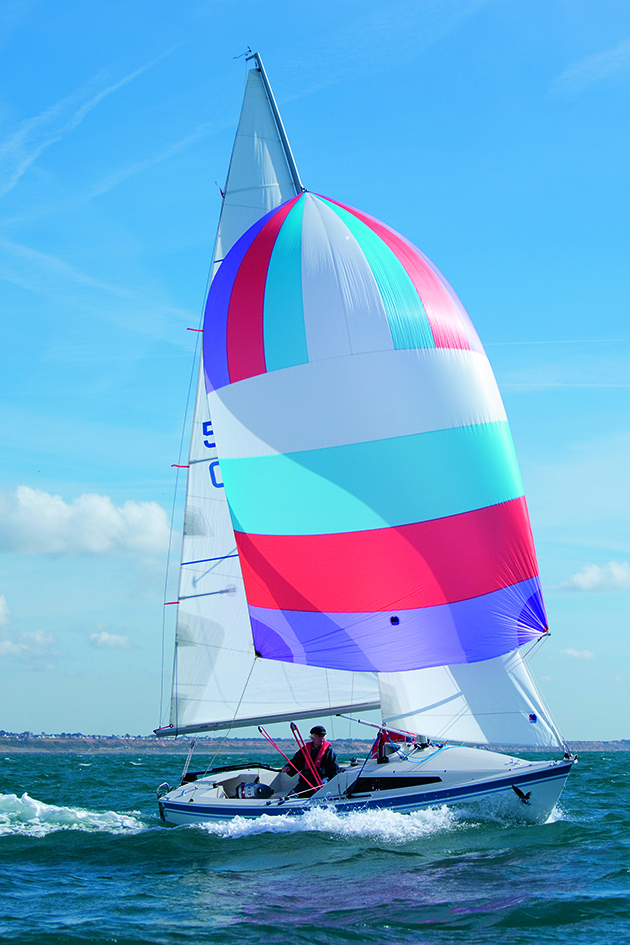
Downwind is where the Hawk 20 excels, readily surfing down the waves. Credit: David Harding
The breeze started at around 12 knots, giving us 5.3 knots on the wind, and steadily picked up to around 17 knots. As the tide was flowing in the opposite direction, it got a little lumpy over Christchurch Ledge, but the boat took it all in her stride and kept us remarkably dry.
The great thing about large mainsails that are easy to de-power is that they seldom need reefing.
As with most racing keelboats, if it’s windy enough to reef, it’s probably too windy to go out, though the Hawk 20 does come with a couple of reef points for times when you want to take things gently.
Upwind, she proved delightfully positive and responsive, handling just like a big dinghy.
This is one of those boats that makes you want to sail for the simple pleasure of sailing; whereas all too many feel as though they’re being pushed through treacle, she answers to every tweak of the sheet and movement of the tiller in a way that encourages you to get the best from her.
At the same time, punishment is muted if you get it wrong, so anyone moving down from bigger boats will have nothing to fear.
A growing number of sailors these days bypass small boats altogether, depriving themselves of the chance to develop the instincts and reactions that can only be acquired by racing dinghies, so sailing something like the Hawk 20 that’s effectively a ballasted dinghy would sharpen up their sailing skills immensely while sparing them the indignity of being tipped in.
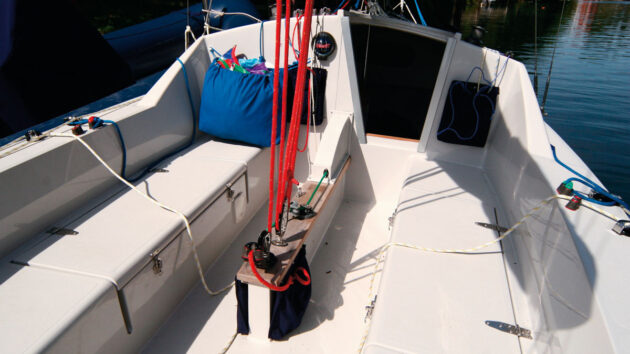
A large cockpit provides plenty of crew space and also simplifies sail handling by allowing easy access to the foot of the mast. Credit: David Harding
The absence of toe straps is a further clue that this is intended as a family boat, though the crew can get his or her bum over the edge by hanging on the shrouds and the jib sheet.
The sheet is on a 2:1 purchase to obviate the need for a winch in a breeze. In light airs, you would want to reduce it to a direct pull.
Similarly, the helmsman can miss out one of the blocks in the 6:1 mainsheet to reduce it to 4:1.
Bearing away and cracking the sheets brought the speed up to 6 knots even in the lighter conditions, while hoisting the kite had us slithering down the waves at over 8 knots.
With her flat hull, the Hawk 20 should be an impressive performer downwind in a breeze. She has been clocked at 12 knots, and I see no reason why she shouldn’t achieve a good deal more.
Flown from a self-launching Spiro pole system, the spinnaker is simple to handle. There are no tweakers – just reaching hooks that are, in fact, over-length, fat-headed clevis pins for the cap shrouds.
On the early boats, it was found that the spinnaker guy kept catching under the pins, so Reid decided to make use of them
Finding the limits of the Hawk 20
With nearly half her weight being in the form of lead castings in the bottom of the hull, it’s no surprise the Hawk 20 feels reassuringly stiff.
The weight would have more effect in a keel, of course, but lifting a heavily ballasted keel involves more work and more complex engineering.
Keeping things simple was the objective with the Hawk 20, so the centreplate is aluminium: a high grade of aluminium on a Delrin pivot to avoid problems with electrolysis.
A proper foil section for efficiency, it’s easy to lift with a purchase that leads to a swivel cam on the top of the case, and the boat is just as stable with it up as when it’s down.
Reid argues that an aluminium plate is less prone to damage than one made from ballasted glassfibre. Even if you didn’t know it was aluminium, you would soon guess when it hits a sandy or shingly bottom because of the metallic noise.
The other factor contributing to the Hawk’s stiffness is her double-chined, flat-sectioned hull.
It’s closer to the shape of a single-chined hull, as on a Mirror or GP14, than to that of double-chined dinghies such as the Enterprise or Wayfarer: there’s minimal deadrise and the lower chine is below the static waterline for much of its length.
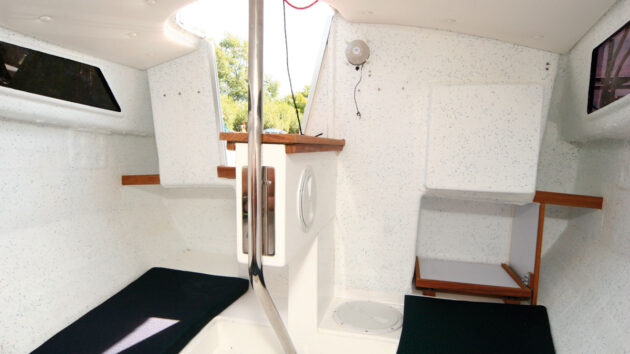
Luxurious it’s not, but the cabin is more than adequate for weekending – especially if combined with a cockpit tent. Credit: David Harding
Form stability is therefore enormous, and although it looks like a hull that was designed for plywood construction, it has been built in GRP from the outset.
One function of such a fine entry, broad stern and flat-bottomed hull is that the boat inevitably rounds up when pressed beyond a certain point.
The rudder blade is big enough to keep her on track most of the time, but by about 20° of heel, the helm is getting heavy.
If you don’t do something about it, the rudder loses grip just before the gunwale dips below the water.
In some ways, that’s a safety valve and means you’re unlikely ever to ship serious amounts of green water, though I would prefer to have some balance on the blade to reduce the tug on the tiller in normal sailing mode.
It was a little heavier than I found comfortable and could easily be reduced by a tweak to the blade at the bottom of the stock to allow it to swing further forward.
One more change I would make if not racing (it would be outside the class rules) would be to narrow the jib’s sheeting angle: the tracks are on the gunwale and, as a result, the tacking angle is close to 90°.
For a boat that’s otherwise as efficient as the Hawk 20, that’s a bit of a let-down.
It would be easy to move the tracks inboard, on to the top of the coachroof or, alternatively, to rig up a barber-hauler arrangement. The angle is a little narrower on the dayboat, and, in any event, the shorter superstructure would preclude moving the tracks inboard.
At the moment, it seems a waste of the cruiser’s potential to live with this limitation upwind.
In terms of function, those would be the critical tweaks. The change I would like aesthetically is a lower stern and a higher bow, because the Hawk 20 always looks as though she’s trimmed down by the bow.
She’s not: it’s nothing to do with ballast placement or the longitudinal centre of buoyancy, just that she has a broad and relatively high stern and a fine, sharply raked and rather low bow.
This doesn’t make her a wet boat to sail – she’s remarkably dry – but to me it just doesn’t look right.
Practical solutions
Given the number of happy Hawk 20 owners, things like rudder balance, sheeting angles and a slightly bow-down appearance don’t seem to have put too many people off.
It’s no surprise: this is a great boat full of sensible ideas.
You don’t need to worry about capsizing, and neither is swamping a problem, because the cockpit sole is above the waterline, and a pair of self-bailers at the aft end will dispose of any water that comes aboard.
You can leave them open when the boat’s on the mooring to stop her filling up.
Even in extreme conditions, she should stay afloat because blocks of polyurethane foam are enclosed on both sides of the outboard well, beneath the cockpit and below the bunks in the cabin.
When the wind dies or you need to punch the tide through the harbour entrance, help can be summoned from an outboard of between 2.5hp and 6hp.
As befits a boat designed to sail, it lives in a well that allows it to be lifted clear of the water.
Having hinged it up, you drop two fairing plugs into the gap: they fit flush with the hull to eliminate any turbulence.
Sailing without the plugs in position would be intolerable: the sloshing and gurgling would drive you mad, and it would be like towing a large bucket.
Just out of curiosity, when running back up the harbour under spinnaker, we watched the speed while first removing the plugs and then lowering the engine.
With the plugs removed, we dropped from 4.5 knots to 4. Lowering the engine took off another half-knot, and dropping the spinnaker brought us down to a get-out-and-walk 3 knots.
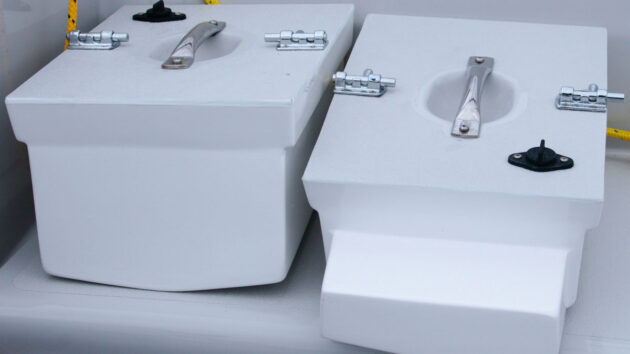
Fairing plugs fit into the bottom of the hull to eliminate turbulence when the outboard is raised. Credit: David Harding
Under engine, she’s nicely manoeuvrable because the prop is immediately forward of the rudder, though for close-quarters work it’s simplest to lift the rudder entirely and steer using the engine alone.
In a chop, the well helps to keep the prop immersed.
Apart from my well-aired gripes, everything about the Hawk 20 is well thought out.
Equipment is universally good: deck hardware is from Harken, spars from Seldén and sails (with sliders on the luff of the main) by Sanders in Lymington.
An Easykick rod kicker stops the boom crashing down on unwary heads when the main is lowered, and there’s also a topping lift.
The aluminium rudder stock and tiller assembly are substantial, and the blade is made from tongue-and-groove timber.
Mouldings are fair and free of any flexing.
At 2.5m (8ft 2in) long, the cockpit is roomier than that on many large cruising yachts. It has lockers on either side, nicely flowcoated and with good rubber seals and proper clasps that can be padlocked.
In here, you can stow the hull-fairing plugs when the outboard’s in use, together with the washboards and companionway hatch.
When it comes to packing up and trailing her home, the mast simply hinges down. Then you winch her on to the braked, break-back trailer and off you go.
Drawing a modest 23cm (9in) with the plate raised, she doesn’t need a lot of water to float on and off.
Compact cabin
Dropping down through the companionway, you find two bunks 2.03m (6ft 8in) long that can be filled in to create a wall-to-wall berth, divided at its after end by the centreplate case and the cranked compression post.
To port is a slide-out shelf for a single-burner gas cooker, and there’s space for a chemical toilet to port. Headroom above the bunks is ample at 90cm (2ft 11in).
Most owners forgo luxuries like batteries and lights, but they can be fitted. Trim is minimal: just a few headlining panels.
Verdict on the Hawk 20
It’s refreshing to find a boat that hasn’t been spoiled by too many compromises.
The Hawk 20 is fast, fun and functional. Designed and developed by people who understand sailing, she’s also robust, safe, well-proven, seaworthy and forgiving.
Her sharply raked bow is a clue that she has been around for a year or two, but the competition is still minimal: few other all-rounders have proved to have the same versatility and appeal.
Especially now that more people are coming to appreciate the benefits of small, trailable boats, the Hawk 20 Cruiser should have a healthy future.

